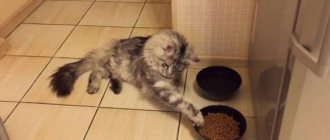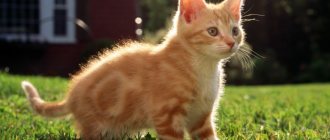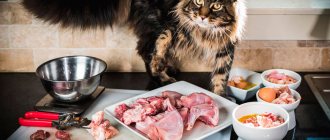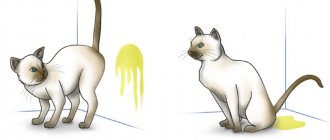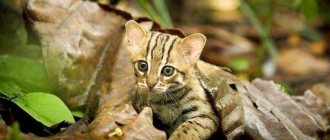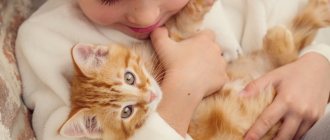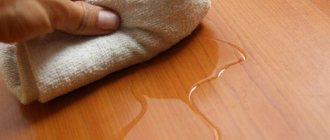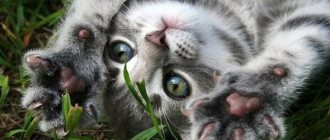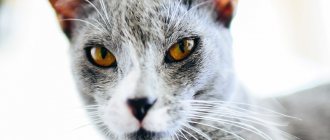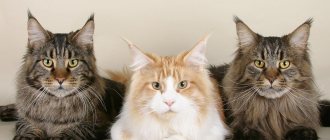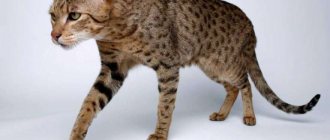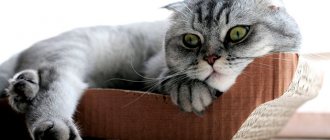The Norwegian Forest Cat is a long-haired breed, especially popular in Scandinavia and Northern Europe. Breeders and fanciers affectionately call these cats Norwegians, and in their homeland in Norway they are called “skogkatt”; they are proud of their furry pets as a national treasure. These cats are a combination of the beauty and grace of a domesticated predator.
Description of the breed
The Norwegian Forest Cat has the following breed description:
Body. Has a strong build. The size and weight of females is about 6 kg, males – 9kg.- Paws. Due to the difference in length between the front and rear, it creates a gradual rise from the body to the tail of the animal. The paws themselves have a triangular regular shape.
- Head. The animal's forehead is wide with a weakly defined transition. The contour of the skull is smooth and should not have any unevenness. The lower jaw is rounded. Straight long nose.
- Eyes. Large sizes oval shape. Located at a slight angle relative to each other. The color can be any, without reference to coat color.
- Ears. According to standards, they must be large and rounded at the ends. In front they look vertical, but in profile they have a slight tilt forward.
- Wool. The Norwegian Forest breed is a semi-longhaired breed. The length of the hairs differs on individual parts of the body. The longest is on the collar and pants of the hind legs. It has a double undercoat, which provides protection from the cold and good water-repellent properties.
Question to the expert
Why are Norwegian Forest cats so fluffy?
The special structure of the wool became possible due to adaptation to the harsh cold climate of Scandinavia. Animals had to survive in such conditions and find their own food.
Basic and rare colors
Coat and colors require special attention. According to current breed standards, a variety of coat colors are allowed. The main ones are:
- Plain or solid. These are black, white, gray, blue. There should be no inclusions of a different color on the entire surface of the body.
- Smoky tones. These include ticked individuals. The hair of such cats has different colors along its length.
- Warm. These are red or red.
- Tabby. Various variations of red and red shades.
- Marble color. Characterized by a pronounced pattern against the background of the main color.
- Various combinations with white. These include black and white, white and red and other possible options.
Marble, tortoiseshell, spotted - these colors should have a clear pattern. Such a kitten can be two or three colors. This richness can be explained by their habitat. The color of the animal should not stand out against the natural background, which provides it with camouflage for a successful hunt.
Norwegian forest cat.
Differences from the Siberian cat
The Norwegian Forest Cat is similar to the Siberian Cat. Many people may confuse her with a coon. Norwegians and Siberians developed in similar natural conditions, which became the reason for their similarity.
Despite this, an experienced breeder will quickly distinguish between these animals. The Norwegian cat has a straight nose, while the Siberian cat has a slightly snub nose.
They differ in size - the Siberian is slightly larger than its fellow from Scandinavia. One of the main differences is the shape of the skull.
The Norwegian cat has a triangular head shape, while the Siberian cat has a more rounded head. Another breed similar in appearance, the Maine Coon, is distinguished by a skull similar in shape to a square. The photo on the side shows these differences more clearly.
Differences from Maine Coon
The main difference between these two breeds is the structure of the skull. The Coon has a wedge-shaped head, while the Norwegian cat's head resembles a regular triangle with a flatter forehead.
Caring for a Norwegian Forest Cat
The thick and long double coat does not require special care. It is enough to comb the animal once a week. In the spring, when cats shed, they need to be brushed almost daily - up to four times a week.
If you are preparing a Norwegian for a show, grooming becomes more difficult. Forest fluffies have thick skin. This is a necessary condition for the wool to be waterproof. To make the coat look decent, breeders advise using special products for oily wool when bathing.
Thick and dense wool is not easy to wet properly. These are consequences of the water-repellent effect conceived by Mother Nature to preserve the life of the animal in the harsh conditions of cold forests. To wash the animal's fur, you need to thoroughly lather the entire body with shampoo several times and rinse.
After bathing, the luxurious fur coat needs to be combed. Otherwise, tangles cannot be avoided, especially on the paws and stomach. Under no circumstances should you dry your pet with a towel! This will only tangle the thick fur. It is better to leave the cat alone so that the fur dries on its own. As a last resort, you can use a hairdryer.
The claws of forest animals are trimmed once a month. Check your cat's eyes and ears regularly. Wipe your eyes with a cotton pad as they become dirty, and you can clean your ears with cotton swabs or cotton swabs.
Feeding a Norwegian Forest Cat
Norwegians eat more than most other cat breeds. Nutrition has a huge impact on the well-being, health and appearance of your pet. The required daily calorie intake for an adult female is approximately 300 kcal. This is approximately 70 grams of dry food per day. Cats eat more because they are larger in size. The daily norm for an adult male is from 90 to 120 grams of food. Choose super-premium food with a good composition.
It is more difficult to properly balance a Norwegian’s diet with natural products. The cat's menu should include lean meat, kefir, yogurt, eggs, offal, boiled vegetables, and thermally processed sea fish. To maintain good appearance, consult your veterinarian about vitamin supplements for your food.
Habits and character
The Norwegian cat has a calm, balanced character. Little kittens quickly get used to their new place, they like to spend a lot of time with a person. They do not like to sit on their hands or knees; they will comfortably sit next to them on the sofa.
They are distinguished by their stubbornness; getting these cats to do anything is difficult or even impossible. However, they get along well with other pets.
There is no need to worry if there are children in the family. Thanks to their developed hunting instincts, they like to play with balls and “rustles.” Such entertainment will appeal to the child and the animal itself. In this case, aggression towards people is not typical for them.
Conflicts, and especially fights, are an exception to the rule for a Norwegian cat. They will do their best to avoid this. However, if violence is shown to them from other animals, they will receive it in return. It is important to take into account the size of the cat; most likely it will come out the winner.
Buy a Norwegian Forest Cat
Scandinavian nurseries are common not only in Europe, but also in our latitudes. There is a large Norwegian nursery in Kyiv. In Russia, nurseries operate not only in the capital, but also in the regions (for example, Penza region).
It is dangerous to buy a long-haired Norwegian on Avito and Yula; you can buy an animal of the wrong breed for a hefty sum. It is better to contact trusted breeders.
Diseases and health problems
Evolution and natural selection in conditions of constant frost have formed good immunity in the Norwegian breed. Human intervention in this process made its own adjustments. These cats are prone to a number of diseases:
Restructive cardiomyopathy. Deterioration in the elasticity of the muscle tissue of the heart, as a result of which heart failure develops, which can cause the death of the animal.- Diabetes and other endocrine system disorders.
- Arthrosis of the hip bones.
- Retinal dysplasia. It is an abnormal formation of the structure of the layers of the retina, which occurs in the prenatal period.
- Chronic renal failure.
- Glycogenosis. The disease disrupts metabolic processes in the liver. Typically, kittens with this disease are born dead or nonviable. Some individuals can live up to 4-6 months.
- Purivate kinase deficiency. A decrease in the number of red blood cells in the blood and the development of anemia.
The last two diseases are rare. Professional breeders, in order to avoid such consequences, conduct special blood tests, and are also picky about the choice of partners for mating.
If an animal receives proper nutrition and timely vaccination, the average life expectancy of an animal approaches 15-17 years.
Reviews
I suggest you learn more about the breed by reading reviews from owners of Norwegian cats. All comments are taken from the Otzovik website.
Royal character
The author of the first review says that life with a Norwegian cat is quite comfortable. Good grooming of the coat is important, otherwise it will mat and form tangles. The cat exhibits hunting skills and loves to spend time contemplating what is happening in the house or outside the window.
Antidepressant cat
The author of the second review is the owner of two gorgeous cats – Norwegian and Siberian. Animals are very friendly with each other. There is a certain whimsicality in nutrition. The Norwegian cat is very smart and impresses with its intelligence, and also loves to play.
Active animal
From the third review we learn that his Norwegian cat has human character traits: moderately stubborn, moderately kind and affectionate. The author says that the pet’s playfulness remains even in old age. The cat is not a hassle to keep, but it still needs to be brushed regularly.
How to choose a kitten
Since the Norwegian breed can be confused with the Siberian and Coons, you need to choose kittens especially carefully. It is better to choose reliable nurseries that value their reputation and name. The risk of getting an individual with a cross is minimal. When choosing a kitten, you should follow some recommendations:
- availability of genetic tests for the presence of hereditary diseases;
- small kittens should be active, play with each other, and make good contact with humans;
- gums should be pink;
- the eyes have no clouding or discharge;
- the tail is straight, without creases or bends;
Many people choose a pet based on its color. The cost of the animal largely depends on this factor.
What is the price
The price of a cat depends on the reputation of the cattery, color, pedigree and other factors. The average cost of a kitten is 35-45 thousand rubles. Show-class individuals can cost up to 150,000 rubles.
How to name a kitten
The name for a kitten of the Norwegian breed is often chosen from the mythology of the ancient Vikings. The most common nicknames include the following:
Table of popular names for cats and cats.
Breeding Features
This breed appeared in our country relatively recently. In many ways, this is why kittens are expensive. Finding a good, reliable nursery, especially in some cities, will be problematic.
Breeding these animals does not have any special difficulties or difficulties. The most important issue is finding a mating partner.
Origin story
There are two versions of the appearance of the breed. According to the first, the Vikings brought Angora cats to Norway, they mixed with the local ones, and as a result a special breed was formed.
According to the second, the breed appeared due to the crossing of a domestic cat with a lynx. This version is supported by the fact that the cat is able to easily climb tall trees, it has tufts on its ears, like a lynx, and the claws of a predator.
The Norwegian breed was standardized in the 20th century. From that moment on, purebred breeding began. Today, the forest cat is distributed throughout the world, and the breed is popular in regions with different climates.
Features of behavior
European forest cats are very careful, they can even be called shy. This often leads to manifestations of aggression towards strangers. These cats especially avoid human settlements and try not to be seen by people at all. In general, they prefer not to enter into conflicts with their relatives or with any other predators.
They live alone. An adult male is able to control a forest area of up to three square kilometers. To mark boundaries, the cat leaves marks from physiological secretions and claw marks on tree trunks. Therefore, strangers rarely wander into its territory.
The European forest cat has many natural enemies - lynx (Lynx), large steppe cat, jungle cat (Felis chaus), fox (Vulpes Vulpes), gray wolf (Canis lupus), jackal (Canis aureus), marten (Martes martes), bear (Ursus arctos). In Tajikistan, the wolf is the most serious competitor for the Forest cat; quite frequent destruction of cat holes is observed here. Birds of prey, including the Eurasian eagle owl (Bubo bubo) and saker falcon (Falco cherrug), are often quite successful at preying on cat kittens. Naturalist Seton Gordon recorded an incident where a Forest cat fought with a golden eagle (Aquila chrysaetos), resulting in the death of both parties.
The animal spends most of the daytime in a den, most often built in an old hollow in a large tree. Tree hollows usually contain enough sawdust, so the cat does not make additional bedding. If fleas appear in the den, the Steppe cat moves to another place. In winter, when snowfall prevents the cat from traveling long distances, it remains in its shelter until the climatic conditions for movement improve.
Those individuals that live in the mountains make rookeries in rock crevices or abandoned burrows of badgers (Meles meles) and foxes (Vulpes Vulpes). They are small depressions under cliffs, dense accumulations of branches; for Wild cats this is not only a den, but also a temporary shelter in times of danger.
Crevices in rocks or holes, equipped as shelters, are lined with dry grasses and bird feathers.
In the floodplains, animals choose wide forks of trees and abandoned nests of large birds, such as herons, for shelter and resting places.
The predator goes out for prey at night, several hours before dawn. But in winter conditions it practices additional hunting early in the morning and late in the evening.
European forest cats living in floodplains control up to one or two hectares of territory, but during the mating season, males can leave the boundaries of their territory in search of females.
The European forest cat is capable of moving very quickly when pursuing prey or escaping from pursuit, and is an excellent climber of trees and low rocks.
The animal has excellent hearing and vision, and a slightly lower level of smell. It is silent, but capable of making low and hoarse meowing sounds, and can purr, snort, purr, and hiss.
Due to the large number of enemies in the forest, from which, however, the predator is able to instantly hide in trees and rock crevices, the appearance of the beast is associated with a gloomy and wary creature. Nevertheless, this is one of the most beautiful and noble animals in the world, somewhat reminiscent of an exotic domestic cat.
Top nicknames
Simple common nicknames are not suitable for purebred cats. The owners try to name their new pet unusual and interesting. The nickname should not only please all family members, but also be easy to remember. Examples of the most common names for the Norwegian forest cat are given in the table.
Table - Top nicknames
| First letter of nickname | Nicknames for the Norwegian Forest cat “boy” | Nicknames for Norwegian Forest Cats - “girls” |
| A | — Excitement; — Azazello; — Ataman | - Agasha; - And I; — Alko |
| B | — Leopard; — Bruce; —Breaststroke | — Bagheera; — Blanca; — Bessie |
| IN | — Jack; - A vampire; — Viscount | — Veysey; — Freckle; - Snowstorm |
| G | — Gast; — Hussar | - Gressi; - Storm |
| D | — Joker; -Savage | — Dessie; — Jaggy |
| E | - Yenisei; — Yeshka | — Fidget; - Christmas tree |
| AND | — Zhaur; — Georges | — Jeanette; — Juliette |
| Z | — Zeus; — Zenit | - Fun; — Zara |
| AND | — X; — Indigo | — Willow; — Butterscotch |
| TO | — Cadet; — Karabas | — Cassie; — Christy |
| L | — Lorch; — Lex | — Lady; — Lixie |
| M | — Marcus; — Mars | — Myrta; — Miss |
| N | - Narcissus; — Newton | — Nellie; — Nessie |
| ABOUT | — Odysseus; — Orion | — Orta; — Ocher |
| P | — Pegasus; — Perseus | — Pandora; — Fir |
| R | — Ramses; —Rigi | — Roxana; — Rosinka |
| WITH | — Saiga; — Stanley | — Sabrina; — Starkey |
| T | — Typhoon; - Tiger | — Mystery; — Tim |
| U | — Uranus; — Cliff | — Ulana; — Ursula |
| F | — Bassoon; — Frant | - Fabby — Violet |
| X | — Swag; — Hippie | — Happy; — Helma |
| C | — Caesar; — Cyclone | - Queen; — Tsya |
| H | — Charlie; — Sorcerer | - Chibi; — Chucha |
| Sh | — Cartoon; —Chief | Shelley |
| E | — Edwin; — Eric | — Aegis; — Elite |
| YU | — Yuji; - Cabin boy | — Juno; — Younessa |
| I | Jaguar | Janika |
